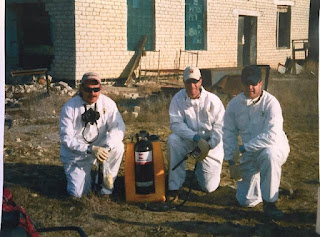Excerpts from the upcoming book…"Digging Deep; The Voz Island Destruction Mission" by Mission Commander Brian Hayes
Before the start of the
Cold War, Voz Island in
the Aral Sea (then a part of the Soviet Union), was an unassuming place. Apart
from a few locals working at a small fish processing plant, nothing much
happened there. That all changed quite dramatically in 1948 after Stalin’s
government decided to open a top-secret biological weapons research facility on
the island.
A Historical Perspective
A
child of Stalinist paranoia and the “arms race” to develop biological weapons
to use against the West, Kantubek was the Soviet’s largest research center
devoted to the cause. Approximately 1,500 inhabitants lived on the island full
time, all of which risked their lives, both in doing the job and if they spoke
out about it.
Kantubek
was chosen not only for its remote, off-limits location but also for the warm,
dry climate of the Aral region…the reality this place gets HOT!
With
a ground-level temperature of 100 degrees plus all summer long, the conditions
were perfect for limiting the spread of pathogenic microorganisms. Professor Ivan Velikanov, a specialist in bacteriological
warfare headed the facility, leading some of the most ambitious biological warfare
testing ever conducted in a field like environment such as this site provided. However,
after a decade in charge of the unit, he became a victim of Stalinist terror.
For undocumented reasons, he was discharged and later, executed. For a short
while, the facility was put on hiatus. This ended after a 1952 ratification by
the Soviet authorities (still led by Stalin) to resume the experiments.
More funding saw a large-scale expansion of Vozrozhdeniye Island. An airport was added to the west of the island, the only one in the USSR with four tracks in a star-shape, created so that planes could land from any direction during strong winds prevalent on the island. (Note: See my previous article about Barkhan Airfield)
More
sophisticated laboratories were developed. A port complex was also built to
enable constant patrol of the waters around the island. Experiments were now
being conducted on the most dangerous pathogenic agents in the world, including
anthrax, various toxins, typhus, and brucellosis. Any data leak could have
proved catastrophic to the Soviet government as these materials had the
capacity to decimate populations on a grand scale.
That’s
until the leak at on 2 April 1979, where spores of Anthrax were accidentally released from a Soviet military research facility in the city of Sverdlovsk, Soviet Union now Yekaterinburg, Russia.
Overview
In
1988 orders came from Soviet leadership to quickly dispose of the anthrax at
Sverdlovsk-19 in advance of a suspected international inspection. Under duress,
germ scientists at the facility in Sverdlovsk (also known as Compound 19)
scrambled to move hundreds of tons of anthrax with little to no warning. The
infectious agent was loaded into stainless TR-250 containers and prepared for
shipment out of the area.
To
neutralize the anthrax Compound 19’s scientist’s added sodium hypochlorite - that when
dissolved in water equals bleach - which served as a disinfectant and
antimicrobial agent prior to transport. The
containers were then sent to Voz Island, where they were emptied into
eleven pits northwest of the laboratory complex in an area known as PRSL-52.
We located the burial pits with satellite imagery provided through intelligence contacts and hand drawn sketches obtained through exhaustive interviews with individuals who had worked on the island and “knew” the precise location as well as numerous trips to the island to confirm the precise geo locations and scouting for other sites place the team for future missions.
When finally excavated, it was evident that because spores
tend to clump together when dry, some were protected from the bleach and
remained viable. And this presented a new issue – we were dealing with a
weaponized biological agent in the middle of the Aral Sea without ANY formal
security measures to secure this material.
More to follow…..


